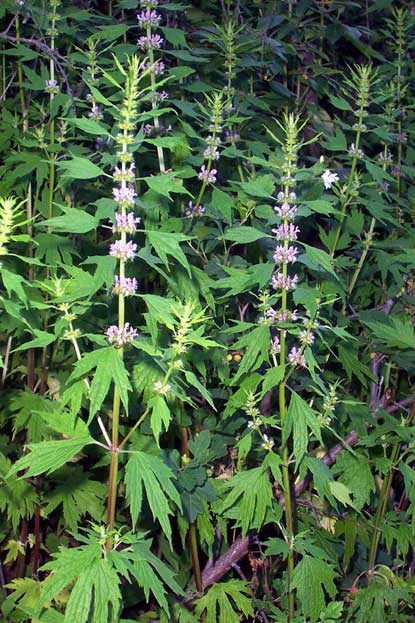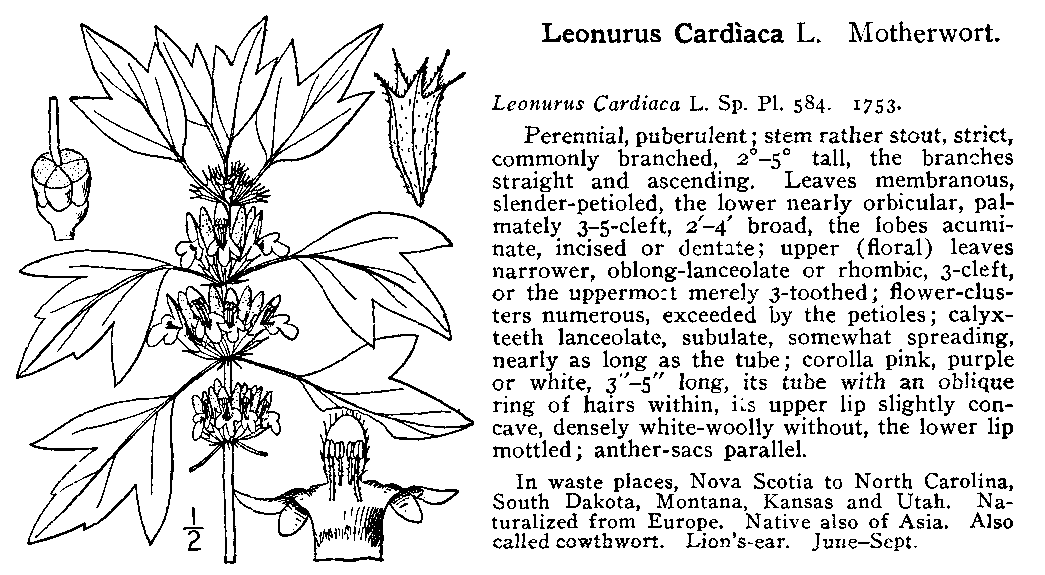INTRODUCTION: WHAT IS LEONURUS CARDIACA AND WHAT ARE THE COMMON USES OF THIS PLANT?
1) General Characteristics
Leonurus cardiaca is a herbaceous perennial plant in the mint family, Lamiaceae.
In Italy this plant is known with the common name of "Leonora Cardiaca" or "Cardiaca".
Other common names (in English vocabolary) include Motherworth, Throw-wort, Lion's Ear, and Lion's Tail. Lion's Tail also being a common name for Leonotis leonurus, and Lion's Ear, a common name for Leonotis Nepetifolia.
This perennial plant indigenous to central Europe and Scandinavia, but it is also found in the area spanning temperate Russia to central Asia.
It has been introduced to North America and has become established locally in the wild. Motherwort (Leonuri cardiacae herba) consists of aerial parts of Leonurus cardiaca gathered during the flowering period, dried at 35°C and, according to European Pharmacopoeia 7th edition, should contain a minimum of 0.2% flavonoids, expressed as hyperoside.
Compounds belonging to the group of monoterpenes,diterpenes, triterpenes, nitrogen- containing compounds, phenylpropanoids,flavonoids and phenolic acids, as well as volatile oils, sterols and tannins, have been identified in motherwort.
2) Common Uses
Traditionally, extracts of the herb have been used internally, mainly for nervous heart conditions and digestive disorders. However, they have also been used for bronchial asthma, climacteric symptoms and amenorrhoea, as well as externally in wounds and skin inflammations.
Mild negative chronotropic, hypotonic and sedative effects can be attributed to the herb and preparations thereof. Pharmacological studies have confirmed its antibacterial, antioxidant, anti-inflammatory and analgesic activity, aswell as its effects on the heart and the circulatory system. Sedative and hypotensive activity has been demonstrated in clinical trials.



PLANT CONSTITUENTS
Compounds belonging to different chemical groups have been identified in the
Leonuri cardiacae herba and we can list them:
- Terpenes are represented by monoterpenosides, di- and tri-terpenes.
- The nitrogen-containing compounds are pyrrolidine-type alkaloids and stereoi-
somers of 4-hydroxystachydrine, imines guanidine derivative: leonurine-syringic acid ester and 4-guanidino-1-butanol, and amine choline.
- Other constituents include flavonoids, particularly quercetin and kaempferol O-glycosides: rutin, hyperoside, quercitrin, isoquercitrin,astragalin, as well as apigenin; flavonoid C-glycosides: vitexin and isovitexin; free agly-cones (quercetin, kaempferol, genkwanin); genkwanin is proposed as a chemotaxonomic marker of the Leonurus genus
- The phenolic compounds include phenylpropanoid glycosides:lavandulifolioside: arabinoside ofverbascoside

Pharmacological activity
Pharmacological studies have confirmed antibacterial, antioxidant, anti-inflammatory and analgesic activity, as well as the effects of the herb on the heart and circulatory system. Sedative and hypotensive activity has been demonstrated in clinical trials.
The use of motherwort is mainly based on traditional indications as pharmacological studies are limited.
Antimicrobial activity
The labdane-type diterpenes are probably responsible for the antimicrobial activity of motherwort. A chloroformic extract of motherwort leaves, rich in diterpenes, inhibited the growth of Staphylococcus aureus whereas a chloroformic fraction of a methanolic extract of its aerial parts showed activity against the multiresistant strain of Plasmodium falciparum (Tasdemir et al., 2005).
A fraction obtained from the chloroformic extract, containing labdane-type diterpenes: was also active against this strain (Agnihotri et al., 2008).
An aqueous extract of motherwort almost completely inhibited the development of the tick-borne encephalitis virus in cell cultures, causing greater life expectancy of virus-infected mice and thus proving the induction of immunity.
Antioxidant activity
Extracts from motherwort demonstrated antioxidant activity in several in vitro studies. Polyphenolic compounds, mainly flavonoids (rutin) and derivatives of hydroxycinnamic acid may be responsible for this effect.
For more info:
Flavonois on Flipper and hydroxycinnamic acid on Wikipedia.

Neuroprotective effect
The neuroprotective effect of synthetic leonurine on nerve cells in an ischaemic stroke model (in vivo, in rats) was demonstrated by a reduction of the stroke area, and motor and behavioural changes indicating brain injury. In the study group, a lower level of generation of reactive oxygen species (ROS), less damage within the mitochondria, decreased proapoptopic Bax protein expression, increased expression of anti-apoptopic Bcl-2 protein (involved in the signalling pathways for the programmed death of the cell) and a limited outflow of cytochrome C from mitochondria were achieved. Thus, the neuroprotective effect of leonurine is mainly due to the reduction of ROS formation, by virtue of which proper functioning of mitochondria is maintained and, consequently, inhibition of apoptosis takes place. The investigation suggests that leonurine could be useful in preventing and treating ischaemic strokes due to its antioxidant and antiapoptopic mechanisms.


Leonurine on American Stroke Association website.
Cardiovascular activity
Intracoronary administration of a Leonurus Cardiaca refined extract to isolated rabbit hearts reduced left ventricular pressure and increased coronary blood flow, lengthened Q-T and P-Q intervals, increased the basic cardiac cycle and activation recovery interval and led to the inhibition of the inward calcium current (blocking ICa.L) and the inward potassium current (IK.r) which are responsible for depolarisation and repolarisation, respectively. The extract lengthened the duration of the action potential and the activation time of the inward depolarising sodium and potassium currents (If) in pacemaker cells of the heart conduction system. The study showed the multidirectional activity mechanism of the extract from motherwort on the heart, corresponding to the activity of class III antiarrhythmic drugs, which justifies its use in tachycardia (Ritter et al. 2010).

Effect on heart potential of class III antiarrhythmic drugs
The potential effect of lavandulifolioside, obtained from a butanol extract of motherwort, on the blood pressure of normotensive rats, and the work on rat hearts isolated from another group of these animals and the effect of the butanolic extract on the heart were investigated. Both lavandulifolioside and the butanol extract decreased the heart rate, lengthened the duration of P-Q and Q-T intervals and QRS complex and decreased coronary outflow. This is in contrast to the experiment carried out by Ritter et al. (2010). The contradictory results may have arisen from variations in the preparation of the extracts. An intravenous injection of 77 mg/kg of lavandulifolioside decreased the systolic blood pressure by 13–15% and diastolic blood pressure by 16–19%. Furthermore, the antihypertensive activity lasted 60 min.
The aqueous extract of a variety of motherwort collected in Romania (Leonurus quinquelobatus) antagonised (150 mg/kg) the pressor activity of norepinephrine given intravenously to dogs a total of two times in continuous perfusions (10 µg/kg/min).
Leonurin, isolated from motherwort and obtained by synthesis, showed a protective effect on the myocardium in the ischaemia-induced damage model in rats (in vivo) by reducing lipid peroxidation and apoptosis (not only benefit in stroke, but also in IM). The compound was administered intraperitoneally in two doses: 7.5 and 15 mg/kg/day for seven days preceding the ligation of the left coronary artery, which resulted in ischaemia and myocardial infarction. Leonurine (15 mg) diminished the levels of two enzymes: lactate dehydrogenase and creatine kinase, of which increased levels in blood serum indicate damage to the heart. As a result, low values of malonic dialdehyde, originating from lipid peroxidation, and high concentrations of superoxide dismutase, participating in the protection against reactive forms of oxygen, as well as a decrease in proapoptopic Bax gene and protein expression and increased expression of anti-apoptopic protein Bcl-2 were observed (view previous image for Bcl-2 pathway).

Results of old studies (1949) on various preparations of motherwort (tincture, alcoholic liquid extract, dry extract and infusion) used in a group of 100 patients (aged 18–65) suffering from nervous cardiovascular conditions, hyperthyroidism, atherosclerosis and heart diseases, and hypertension were published. After 3–4 days of treatment with tablets containing liquid and dry extracts, reduced palpitations and sensations of tightness in the heart area, and weakened tachycardia and nervous excitability in people suffering from hyperthyroidism were observed. The best results of the treatment with motherwort preparations were obtained in the group suffering from nervous heart conditions and hyperthyroidism. In the patients with essential hypertension, after 8–10 days of treatment, there was a decrease of 8–20 mmHg in blood pressure, and headaches and dizziness were alleviated. However, in cases with heavy heart ailments, therapy with preparations of motherwort proved to be ineffective.
Other pharmacological uses
Leonurus Cardiaca showed also other uses, for example:
A)Analgaesic and anti-inflammatory activity, that is demonstred to be very powerful in some studies.
In the ‘hot plate’ test (53 °C), a water-ethanolic extract of motherwort reduced the perception of pain in mice. The fraction of the extract, containing furanolabdane type diterpenes as well as isolated diterpenes, inhibited abdominal cramps caused by acetic acid more effectively than the parallel-given aspirin or acetaminophen. Ursolic acid, isolated from motherwort, in a model of respiratory burst of neutrophils in vitro had stronger anti-inflammatory activity than indomethacin and acetylsalicylic acid when used as a positive probe.
B)Sedative activity
TRIAL ON RABBITS AND MICE:
- The sedative activity of tinctures of motherwort and valerian root was compared in a study on rabbits, which had electrodes placed on their hind legs. An increase in the measured values of direct current intensity, necessary to cause a contraction of the flexor muscles after administration of the tinctures, was noted with a stronger inhibitory effect on the central nervous system exerted by the tincture of motherwort rather than that of valerian root. A significant sedative effect was observed for a 30% ethanolic extract of motherwort: it prolonged the amount of time the animals spent running through the maze by four, the duration of sleep induced by the barbiturates was increased three times and it reduced spontaneous activity by half.
- Similar observations were applied to an aqueous extract of the aerial parts of a variety of L. cardiaca (L. quinquelobatus), which, after intraperitoneal administration to mice, caused a decrease in motor activity.
TRIAL ON PATIENTS :
- In a double-blind randomised clinical trial, the sedative effects of tablets containing motherwort (50 mg), valerian root (170 mg), lemon balm leaves (50 mg) and hop pellets (50 mg) were compared with a placebo which comprised identical-looking tablets containing 5 mg of valerian root. The study group included 50 males (average age 45.6 years) suffering from alcohol withdrawal syndrome with sleep disorders (mild to severe insomnia), anxiety and irritability. The patients, divided into two groups, received the preparation an hour before bedtime, once a day, and the next day they were given the placebo. Compared with the placebo, a significant improvement in sleep quality and a decrease in the frequency of awakenings and nightmares proved a mild sedative effect of the product used; however, it caused drowsiness the following day. Motherwort could therefore, to some extent, be helpful in disorders associated with alcohol abstinence (Widy-Tyszkiewicz and Schmida, 1997).
- A study to determine if the administration of sedatives, including a tincture of motherwort, decreases the limitation of the ability of the retina to distinguish colours caused by a state of anxiety was also carried out. The experiment involved 26 healthy volunteers with a diagnosed state of nervous anxiety, divided into three groups, and control group consisting of 12 patients without emotional disorders. A decrease in anxiety and an improved ability to distinguish colours, both after the application of tofizopam (benzodiazepine derivative) (10 days) and the tincture of motherwort, were noted, yet the anxiolytic effect of tofizopam persisted longer (up to one month after cessation of use) in comparison with the tincture. The positive effect of the treatment on vision may have resulted from an impact on the GABAergic system in the retina and the brain structures connected with it (Ovanesov, 2005).
- In another experiment, 21 young patients (divided into three groups) with mild symptoms of anxiety and depression were administered melatonin, a tincture of motherwort or a placebo for 10 days (10 healthy volunteers constituted the control group). The quality of sleep and emotional state of the patients as well as their retinal function, i.e. the threshold of excitability to light stimuli and the sensomotoric response time of the process of vision, were evaluated before and after the application of the preparations. The administration of melatonin resulted in increased retinal sensitivity to light and an accelerated sensomotoric reaction. The impact on the process of vision after the administration of the tincture of motherwort was statistically insignificant, and sleep quality improved in some patients only. The anxiolytic activity of the tinctures of motherwort was confirmed, but it turned out to be weaker in comparison with that of melatonin (Ovanesov et al., 2006).
- An oil extract of motherwort (4×300 mg capsules daily for 28 days) was administered to 50 patients with a first (22 patients) and second (28 patients) degree of hypertension, and symptoms such as anxiety and sleep disorders. In patients with a first degree of hypertension, a reduction in the symptoms of anxiety, emotional instability, headaches and sleep disorders was achieved. After 21 days, there was a significant decrease in and normalisation of blood pressure (from 145/96 to 130/87), and the patients reported they experienced less fatigue, improved mood and activity. However, their reduction in heart rate (from 81.7 to 75.4) was not statistically significant. A considerable drop in blood pressure (from 153/103 to 142/92) in patients with a second degree of hypertension occurred a week later than the first group. The psycho-emotional condition of the patients (anxiety, emotional liability, headache and sleep disturbances) was improved seven days before their blood pressure lowered. The hypotensive, anxiolytic and calming effect may have been caused by iridoids, while the lack of anti-arrhythmic action may have resulted from the absence of alkaloids in the prepared extract (Shikov et al., 2010).


C) Uterotonic activity
Leonurine, present in L. cardiaca, but isolated from Chinese motherwort, Leonurus artemisia, stimulated muscles from isolated mice uteruses, significantly increasing the strength and frequency of contraction. In a parallel trial, leonurine caused relaxation of the rat portal vein. The effect of uterus shrinking may justify the traditional use of the species of the Leonurus genus to facilitate placenta expulsion and the collapse of the uterus after childbirth, while the vasodilating activity may contribute to a reduction of blood stasis and the ensuing ischaemia, thereby causing pain, and thus justifying the use of extract of motherwort in dysmenorrhoea.

Dosage, contraindications
Commission E recommends daily use (1–3 times) of infusions prepared from 4.5 g of dry motherwort herb in nervous cardiac conditions and as an adjuvant for thyroid hyperfunction. No health hazards or side effects are known if the prescribed therapeutic dosages are administered properly.
Excessive use may interfere with the existing therapy of cardiac disorders, such as cardiac glycosides. Sensitive individuals may experience an allergic reaction. Motherwort is reputed to affect the menstrual cycle. In view of the documented in vitro uterotonic activity, the use of motherwort during pregnancy and lactation should be avoided. It is also not recommended to individuals under 18 years of age.
Coclusions
Motherwort has a long medicinal tradition. Extracts from the herb have been used internally, mainly in nervous heart conditions and digestive disorders, climacteric symptoms and amenorrhea, as well as externally, in wounds and skin inflammations. Mild negative chronotropic, hypotonic and sedative effects can be attributed to the herb and preparations thereof. Recently, infusions prepared from the dry motherwort herb have been recommended in nervous cardiac conditions and as an adjuvant for thyroid hyperfunction. Compounds belonging to the group of terpenes (iridoids, diterpenes and ursolic acid), alkaloids (leonurin) and phenylpropanoids (lavandulifolioside) may be responsible for the diverse biological activity of Leonurus cardiaca; however, the influence of other groups of compounds cannot be excluded. Pharmacological studies have confirmed the valuable cardio- and neuroprotective effects of the extracts from the herb, as well as the uterotonic properties of leonurine and the anti-inflammatory ones of ursolic acid. Compounds present in the herb also show antibacterial, antioxidant, anti-inflammatory and analgaesic activity. Sedative and hypotensive activity has been demonstrated in clinical trials.
The amount of data on the pharmacological activity of Leonurus cardiaca is still insufficient to fully determine its effects and to justify the traditional use of the plant. It is particularly important to investigate the effect of the raw material on the human body in controlled clinical trials.
Conclusioni Personali
La fitoterapia è un ambito sicuramente molto interessante della farmacologia, anche perchè quasi tutte le sostanze utilizzate storicamente, ma anche ai giorni nostri, in terapia derivano dal mondo vegetale. Basti pensare alla corteccia del salice, tradizionalmente usata per combattere le febbri reumatiche ben prima della scoperta del suo principio attivo chè portò all'Aspirina. Oppure ancora la pianta Datura Stramonium somministrata un tempo sotto forma di sigarette per alleviare i sintomi dell'asma.
Non dobbiamo però dimenticare che un abuso di queste sostanze che ci offre la natura può dare effetti anche gravi, basti vedere gli effetti collaterali possibili con l'assunzione della pianta di cui si è appena parlato ampiamente.
Quindi quello delle piante medicinali è un mondo che è importante conoscere ed anche saper maneggiare, sempre però ricordando al paziente che un abuso di preparati (anche di largo consumo) contenenti piante con proprietà terapeutiche più o meno importanti è assolutamente un atteggiamento da evitare per la salvaguardia della salute.
For more info about Phytochemicals in general see:
Herbalism , Sezione Phytochemicals on Flipper.
Wikipedia .